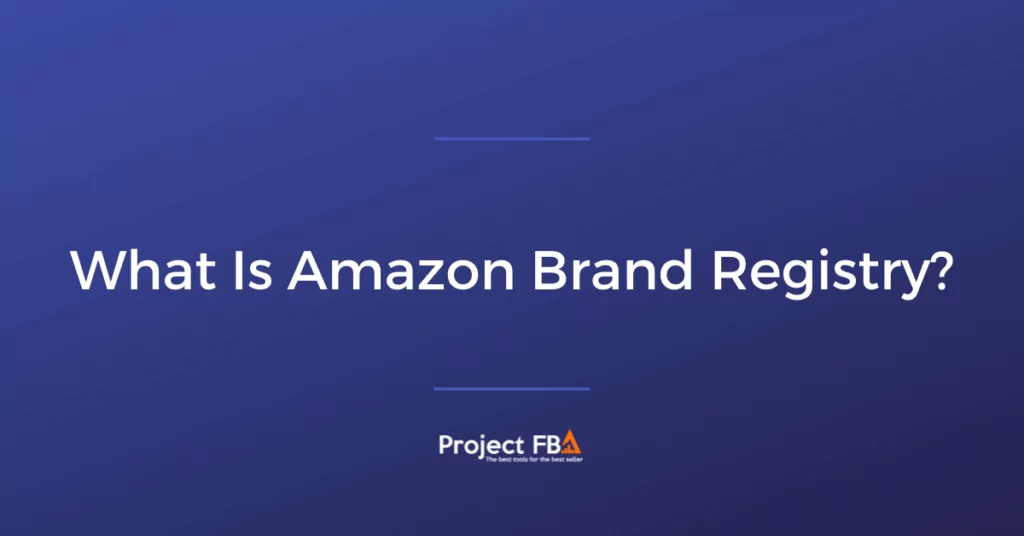If you want to sell products on Amazon, one of the first and most important questions to ask is whether you can sell without joining the brand registry.
The short, sweet answer is yes, you absolutely can.
But things are never quite as simple as the short, sweet answer makes them sound. There are complications and consequences to trying to sell on Amazon without joining the brand registry.
OK, let’s break this down.
What Is The Amazon Brand Registry?

It’s a program that identifies the owners of brands to Amazon. While more or less anyone can sell products from any brand, the brand registry is your defence against someone else copying your brand and selling it as your brand without you seeing a single red cent of the money.
The brand registry is a team that you can report any issues of IP infringement to. If you’re Nike, and someone else purports to be selling Nike running shoes at half the cost, you contact the brand registry and they can help you squash the fraudulent show-people.
Perhaps more relatably, if you’re a small creative firm and you create a cartoon character that goes viral, joining the brand registry means only you and/or the people who pay you money can sell merch with the character on.
Meaning all the would-be jumpers on your bandwagon can be shaken off and you can get your decent remuneration – while also to some extent controlling the branding and the messaging of your character.
Cool, right? Where did that idea come from?
Simply enough, it came from Amazon getting its butt sued a bunch of times by companies whose brands were undermined by scalpers selling fake goods on the platform.
In theory, this was great, but it also represented a shift in reporting responsibility – now it’s not down to Amazon to police who tries to sell what. If you’re a brand owner, it’s down to you to spot any fakers, wannabes, scam artists, and brand thieves.
Because no, your day wasn’t looking quite full enough.
But on the upside, if you’re in the brand registry, you’re… erm… identified as the brand. And only the people you register as official resellers are listed as such.
That makes it easy, if you report infringements to the brand registry, for them to enforce something with the catchy title of Standards for Brands Selling in the Amazon Store.
That means they can restrict would-be sellers from selling products through the much more highly visible Amazon Marketplace, and banish them to Amazon Retail, where they can sell as a vendor.
The risk of selling on Amazon without joining the brand registry is that a) other people might steal that prime selling spot as the brand (though in fairness, some significant checks are made), but more than that, b) you don’t have control of the process, and so can’t raise issues of imposter-sellers.
If you’re not registered as the brand, you’re not recognized as having the authority to start an action under Standards for Brands Selling in the Amazon Store.
So, even if you’re the legitimate brand-owner, you might as well be Joe Blow off the street as far as stopping anyone usurping your brand to sell their knock-off products is concerned.
So, yes, you can sell on Amazon without joining the brand registry. If you own the brand, though, there’s arguably no reason not to join the brand registry.
It usually takes around 24 hours to become accredited as a brand, and it’s free to do. And since the upgrade to the brand registry 2.0, as a registered brand, you get a whole heap of things that didn’t exist before.
Like what?
Benefits Of The Brand Registry 2.0
Like control over the content of your listings. Like a brand monitoring tool, so you can check what happens to your brand across the Amazon Marketplace. Like the ability to add official agents who can access the tools of the brand registry.

And like access to an internal team that can help you track and minimize the effects of any IP infringement, incorrect listings, and the like.
The flipside of all this of course is that if you’re not the brand-owner, and you want to sell branded products on Amazon without either joining the brand registry or getting accredited as a licensed seller by the people who do own the brand, then sure, you can do that – but as a vendor on Amazon Retail, rather than as an official source on the Amazon Marketplace.
And let’s just imagine for a moment that you were a gray market seller with knock-off products to sell.
If the nominal owner of the brand you’re ripping off hasn’t joined the brand registry, you’re pretty much good to go – unless or until they do join it and you subsequently get hit with all the IP infringement claims.
Could you get there first and join the brand registry instead of the legitimate brand-owner?
Significantly harder than you might imagine. How come?
Well, because nobody’s stupid in this equation. When a brand owner joins or tries to join the brand registry, they have to be able to prove three things.
- That they are the owner of an active and registered trademark in that country, and that it appears on either the product or the packaging for that product. The trademark on the product or packaging is laughably easy to fake of course, but being able to prove you own that trademark? That’s where things get sticky if in fact, you don’t own it – while for those who do own it, it should be relatively straightforward.
- That they can verify themselves as the owner of the rights through the public contact listed on their trademark registration. Mm-hmm. No trademark registration? See ya.
- That they have either a Seller Central or a Vendor Central Amazon account.
And if you’re about to try and get the trademark on a brand, be aware, it has to be some sort of text-based trademark, or if it’s an image, it needs to have a textual element.
You try to trademark the swoosh off a brand of popular running shoes? Congratulations, you may own any number of pairs of Nikes – no-one’s going to think you own Nike.
Takeaways

So what are our takeaways? Can you sell on Amazon without joining the brand registry? Without owning a brand, sure you can – as a vendor. That in itself has extra hoops to jump through, but if you don’t own a brand, it’s your easy option.
If you own a brand, then yes, you can sell on Amazon without joining the brand registry. The question, ultimately, is why you would want to.
If you have particular answers to that question that apply in your case, then by all means follow them through and sell without joining the brand registry.
If you don’t have personal, business-specific reasons for not joining the brand registry, we’d say you’re probably missing out needlessly.
Joining the brand registry gets you lots of bonuses, not least the ability to get instances of IP infringement investigated and stopped.
Does it cost you anything? No.
Is it a pain in the butt to do?
Well, let’s just take a look.
How To Join The Brand Registry

To join the brand registry, what exactly do you have to do?
Obviously, go to the Amazon website, and click the button to enrol. It will ask you which country you want to enrol in – choose the US. If you want to enrol in several countries, there is a little hassle involved, as you have to enrol in each country separately.
Remember, there are three main qualifications you need to join the brand registry:
- That you own an active and registered trademark for the products you want to sell, and that it’s active in (eg) the US.
- That you can confirm that you own the rights through the public contact listed on your trademark registration.
- And that you have either a Seller Central or a Vendor Central Amazon account.
In proving these three things, you’ll technically need:
- An image or images of the brand logo.
- Images of products or packaging with the logo clearly displayed.
- A list of product categories in which you’d like the brand to be listed. This is Amazon after all, it’s the largest electronic warehouse on the planet. Without appropriate categorization, your brand could be lost in an electronic nothingness forever
- And a list of countries where your brand’s products are made and distributed
And yes, incidentally, if you were enrolled in the first version of the brand registry, you will need to re-enrol in the brand registry 2.0, as, given the degree to which the brand registry and its services changed at the upgrade, it was felt unfit for purpose to simply carry registrations over from one version to the other.
Is That Too Much Hassle?
Yes, it’s a pain to collect all the necessary proof – especially of course, if your brand has previously lacked a trademark, or hasn’t stamped that trademark on either the products or the packaging.
If that’s your position and it involves a lot of work and expense to trademark and brand your products and packaging, then yes, it might be too much work to join the brand registry just now.
In which case, yes, you can still trade on Amazon, but with significantly less prominence and ability to put your products directly, automatically, in front of those who want to buy them.
But if your products and packaging already have your trademark and your brand on them, then it should be relatively straightforward to join the brand registry – in which case, you lose very little, and potentially gain a great deal.



